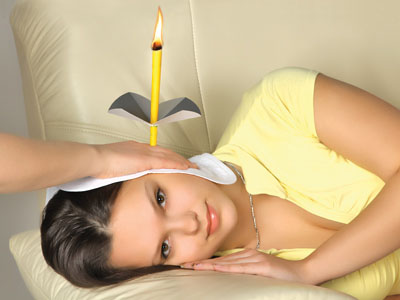

Ear candling, also called ear coning or thermal-auricular therapy, is an alternative medicine practice claimed to improve general health and well-being by lighting one end of a hollow candle and placing the other end in the ear canal. Medical research has shown that the practice is both dangerous and ineffective and does not help remove earwax or alleged toxins. The claim by one manufacturer that ear candles originated with the Hopi tribe also has been disproven.
Ear Coning is a folk medicine practice intended to remove earwax (cerumen) and "toxins" from a person's ear by means of a hollow candle placed in the ear. It involves placing one end of a hollow candle in the ear canal and lighting it. Ear candling has been shown to be ineffective at creating a vacuum and removing impurities from the ear, and has resulted in injuries.
Ear candling is used primarily for cleaning the ears and to promote a healthy atmosphere in the ears, sinus cavities and throat. There are, however, several other benefits. The process can regulate pressure, assist with post nasal drip, sinusitis, catarrh, migraines, some forms of hearing loss, and restoration of equilibrium.
Manufacturers of ear candles often refer to them as Hopi ear candles, referring to the Hopi Native American nation. There is, however, little objective evidence that ear candling is in fact an established treatment within Hopi folk medicine. Allegedly this technique was also used by the ancient Atlanteans, Egyptians, Mayans and Tibetans to cleanse the spiritual and physical body.
Procedure -- One end of a cylinder or cone of waxed cloth is placed into the subject's ear, and the other end lighted. Usually the subject is lying on one side with the treated ear uppermost and the candle vertical, perhaps stuck through a paper plate or aluminum pie tin to protect against any hot wax or ash falling down the side. A typical ear candling session can last up to 45 minutes, during which time a series of 1 or 2 ear candles may be burned for each ear. The experience is generally described as being unusual, but pleasant and relaxing. One may hear some crackling and popping, or feel some heat during the ear candling session.
Warnings -- Ear candling should not be done to people who have ear tubes, perforated ear drums, or artificial ear drums. Ear candlers will use an otoscope to examine their client's ears before and after the session.
Benefits -- The hot air is claimed to melt earwax and create a vacuum that pulls out toxins from the inner ear and the sinuses. At the end of the treatment the subject can be shown the accumulated ash and melted wax inside the candle, which are presented as wax and even fungus drawn out of the ear. Smoke circulating in the ear is sometimes also claimed to have physically beneficial or even mind-clearing effects. The benefits claimed for ear candling are vague and even contradictory, and no scientific studies have been done to document the health benefits of ear candling. Proponents claim significant improvements in their hearing, inner ear pain relief and a reduction in tinnitus symptoms after several ear candling sessions.
Controversy -- Ear candling is generally classified as pseudoscience or even quackery by mainstream medicine, as none of the scientific evidence supports it. Skeptics point out that that there is no mechanism by which the candle could conceivably draw out anything from the ear, and that a sufficient vacuum to do so could not possibly be generated. Nor could the candle create a sufficiently high temperature to "melt" the earwax as is sometimes claimed. Some practitioners of ear candling show accumulations of "wax" inside used candles as evidence that they are effective. However, one European manufacturer, Biosun, points out that these are in fact products of combustion of the candle, which form inside the candle even when it is not placed inside the ear.